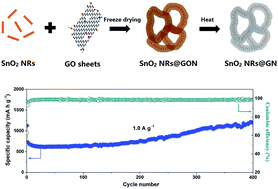当前位置:
X-MOL 学术
›
Sustain. Energy Fuels
›
论文详情
Our official English website, www.x-mol.net, welcomes your
feedback! (Note: you will need to create a separate account there.)
SnO2 nanorods encapsulated within a 3D interconnected graphene network architecture as high-performance lithium-ion battery anodes
Sustainable Energy & Fuels ( IF 5.0 ) Pub Date : 2017-11-01 00:00:00 , DOI: 10.1039/c7se00486a Hui Xu 1, 2, 3, 4, 5 , Dan Wang 1, 2, 3, 4, 5 , Wei Zhang 1, 2, 3, 4, 5 , Jianfeng Zhu 1, 2, 3, 4, 5 , Tong Zhang 3, 5, 6 , Xinli Guo 1, 2, 3, 4, 5 , Yao Zhang 1, 2, 3, 4, 5 , Zhengming Sun 1, 2, 3, 4, 5 , Jian Chen 1, 2, 3, 4, 5
Sustainable Energy & Fuels ( IF 5.0 ) Pub Date : 2017-11-01 00:00:00 , DOI: 10.1039/c7se00486a Hui Xu 1, 2, 3, 4, 5 , Dan Wang 1, 2, 3, 4, 5 , Wei Zhang 1, 2, 3, 4, 5 , Jianfeng Zhu 1, 2, 3, 4, 5 , Tong Zhang 3, 5, 6 , Xinli Guo 1, 2, 3, 4, 5 , Yao Zhang 1, 2, 3, 4, 5 , Zhengming Sun 1, 2, 3, 4, 5 , Jian Chen 1, 2, 3, 4, 5
Affiliation

|
SnO2 nanorods (NRs) have been demonstrated as one of the potential candidates for high-performance lithium-ion battery anodes due to their unique structural features, high theoretical capacity, natural abundance and low cost of fabrication. However, they still suffer from the problem that their direct exposure to the electrolyte leads to the instability of the SEI layer, causing low coulombic efficiency, high ionic resistance and low electronic conductivity. In this study, SnO2 NRs were synthesized by a hydrothermal method, and then spatially confined within graphene sheets by a facile freeze-drying process. The as-fabricated architecture exhibits a full encapsulation arrangement with graphene sheets interlaced into an interconnected macroporous network, serving not only as a robust framework with accessible space for the electrolyte but also a physical barrier layer to prevent the SnO2 NRs from direct exposure to the electrolyte. Moreover, the SnO2 NRs can function as pillars to prevent the graphene sheets from restacking while preserving the highly robust structure and efficient electron and ion transport channels. Benefiting from the admirable synergistic effect between SnO2 NRs and graphene, the assembled electrode shows excellent cycle performance (1179.2 mA h g−1 after 400 cycles at 1.0 A g−1) and rate capabilities (624.2 mA h g−1 at 8.0 A g−1; 458.4 mA h g−1 at 16.0 A g−1).
中文翻译:

SnO 2纳米棒封装在3D互连石墨烯网络体系结构中,作为高性能锂离子电池阳极
SnO 2纳米棒(NRs)由于其独特的结构特征,高理论容量,自然丰度和较低的制造成本,已被证明是高性能锂离子电池阳极的潜在候选者之一。然而,它们仍然遭受以下问题:它们直接暴露于电解质导致SEI层的不稳定性,导致低库仑效率,高离子电阻和低电子电导率。在这项研究中,SnO 2通过水热法合成NRs,然后通过简便的冷冻干燥过程将其空间限制在石墨烯片内。所制造的架构展现出完整的封装结构,其中石墨烯片交织到互连的大孔网络中,不仅充当坚固的框架,为电解质提供可访问的空间,还充当物理屏障层,以防止SnO 2 NR直接暴露于电解质中。电解质。此外,SnO 2 NRs可以充当支柱,以防止石墨烯片重新堆叠,同时保留高度坚固的结构以及有效的电子和离子传输通道。受益于SnO 2之间令人赞叹的协同效应自然保护区和石墨烯,组装的电极显示出优异的循环性能(1179.2毫安汞柱-1 400个循环的1.0克之后-1)和速率能力(624.2毫安汞柱-1在8.0 A克-1 ;458.4毫安汞柱-1 16.0 a g -1)。
更新日期:2017-11-01
中文翻译:

SnO 2纳米棒封装在3D互连石墨烯网络体系结构中,作为高性能锂离子电池阳极
SnO 2纳米棒(NRs)由于其独特的结构特征,高理论容量,自然丰度和较低的制造成本,已被证明是高性能锂离子电池阳极的潜在候选者之一。然而,它们仍然遭受以下问题:它们直接暴露于电解质导致SEI层的不稳定性,导致低库仑效率,高离子电阻和低电子电导率。在这项研究中,SnO 2通过水热法合成NRs,然后通过简便的冷冻干燥过程将其空间限制在石墨烯片内。所制造的架构展现出完整的封装结构,其中石墨烯片交织到互连的大孔网络中,不仅充当坚固的框架,为电解质提供可访问的空间,还充当物理屏障层,以防止SnO 2 NR直接暴露于电解质中。电解质。此外,SnO 2 NRs可以充当支柱,以防止石墨烯片重新堆叠,同时保留高度坚固的结构以及有效的电子和离子传输通道。受益于SnO 2之间令人赞叹的协同效应自然保护区和石墨烯,组装的电极显示出优异的循环性能(1179.2毫安汞柱-1 400个循环的1.0克之后-1)和速率能力(624.2毫安汞柱-1在8.0 A克-1 ;458.4毫安汞柱-1 16.0 a g -1)。











































 京公网安备 11010802027423号
京公网安备 11010802027423号